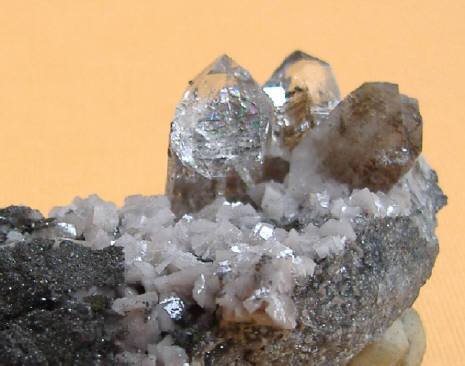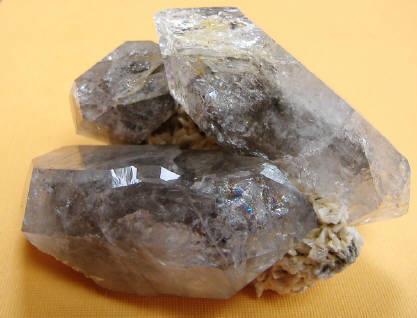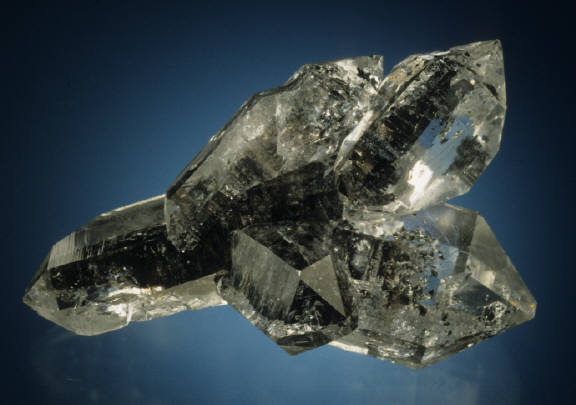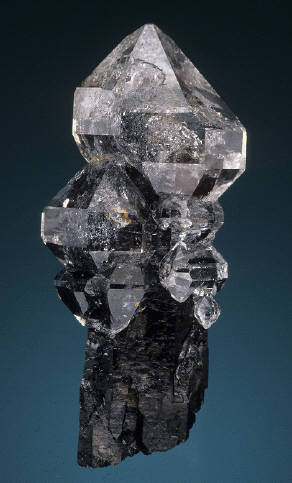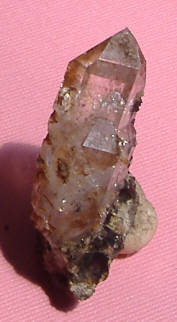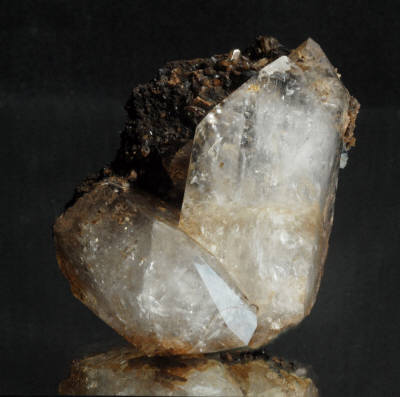This site was last updated on Aug., 2009
The best website on "Herkimer Diamonds"
Larger photos of the thumbnails presented on the main "Crystal Form" page. Evidence is presented here for the occurence of a pre-Herkimer long prismatic habit quartz crystal phase (not a druze!). In some cases additional information and comments are provided for each photo. Under discussion here is whether these elongated crystals should be called "Herkimer diamonds".
Please help with picture donations!
Long prismatic crystals - Do we call these Herkimer diamonds?
A public service project always open to input from the community interested in Herkimer diamonds.
Below left, elongated prismatic quartz crystals, protruding up from a matrix with "saddle" dolomite (white) and a coating of marasite (grey sparkles on the left). The quartz crystals are 12 mm tall. Note the multiple terminations (black arrow), parallel growth, on the right crystal and the phantom inside the left crystal. The specimen is from St. Johnsville, NY. (H/B Quarry) Purchased 2008, Photo Dr. D.
In the photo on the right the elongated quartz crystals (top right crystal is 8 cm long from point-to-point) that are double terminated, but they are not typical in growth appearance for Herkimer diamonds. See the close up below. The appearence of phantoms (is like the photo above), elongated growth and parallel overgrowth all on the same specimen does suggest that this was an interesting crystal growing environment with a few features that might have been slightly different from the typical Herkimer diamond environment. Specimen is from St. Johnsville, NY. (H/B Quarry) Photo Dr. D.
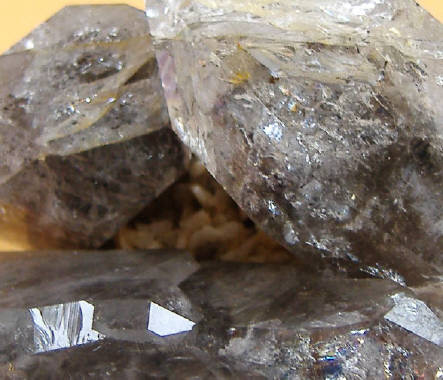
A phantom growth is like a faint ghost duplicate of the crystal, smaller, and mimics the shape of the outer larger crystal. Parallel growth means that the sides of the large crysral will have flattened crytals with terminations pointing in the same direction as the point of the larger crystal (note: there are different types of parallel growth textures in mineral deposits). Both of these features together on the same specimen, with the elongated crystal form, indicate a shift away from the "normal" Herkimer environment.
Quartz Crystal Habits within Herkimer Diamond Deposits
Web page author - W. David Hoisington, Ph.D.
The large prismatic quartz phase is present throughout the Herkimer Diamond mining district. But, it shows strong variations in size, color, degree of phantom development and the degree of parallel growth development.
The photo on the below (left) shows the phantoms inside show the prismatic crystal form that have turned to a dark black color (as compared to the brown shown below). The arrows point to the edges of the phantoms. The specimen is from Little Falls, NY (TM), JoLynne Assoc., 5.1 cm wide. Photo by Jeff Scovil, 1999 - donated 2009.
Scepters are not common in the district but they have been found at TM (where the one in the left comes from), from HBQ, TCR and CG. The Herkimer diamonds are clearly growing over the top of a longer "black phantom" prismatic quartz. This earlier prismatic phase often shows strong parallel growth habit on the surface. You can see more of these scepter photos on the Scovil page. The specimen is from Little Falls, NY (TM), JoLynne Assoc., 7.3 cm tall. Photo by Jeff Scovil, 1999 - donated 2009.
<- Dark prismatic quartz crystal, with parallel growth, that grew BEFORE the Herkimer diamond
It appears that there is a elongated prismatic quartz phase that occurred before the Herkimer phase. It often shows one or more of the following features: phantoms, parallel growth on the faces and parallel terminations. But this prismatic phase is not equally developed across the Herkimer district. In addition, it seems that sometimes the Herkimer phase may totally encase the earlier prismatic phase and not form a scepter.
The question arises, should we continue to call these large prismatic quartz crystals, coming from the Herkimer mining district, "Herkimer diamonds"? Or should the term "Herkimer diamond" be reserved for a particular habit of quartz that occurs in the district?
The same question applies to the recently discovered "Cumberland habit". See the Odd Habit Page.
Below right , elongated prismatic quartz crystals, protruding up from a matrix with brown dolomite and hydrocarbon. There may have been marasite, like the photo on the left, but it is all a yellow rust (common for TCR). The quartz crystals are 4 cm tall. Note the multiple terminations, parallel growth, at the red arrow. The specimen donated by the TCR mine owner, 2010, Photo Dr. D.
Below right , one elongated prismatic quartz crystal, protruding up from a matrix with brown dolomite and hydrocarbon. The specimen was not cleaned, and is shown "as it came out of the ground". The quartz crystal is 3 cm tall. Of important note is the parallel growth on the side of the crystal, at the black arrow. The specimen collected, permission from the TCR mine owner, 2010, Photo Dr. D.
|
